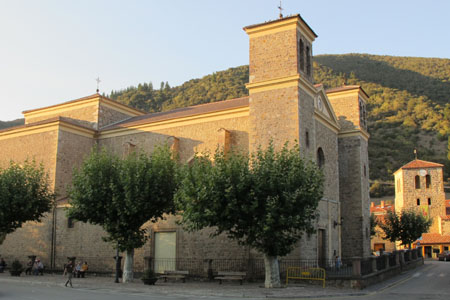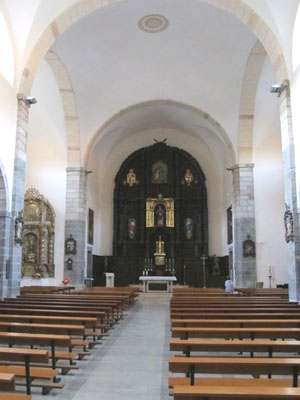| |
 |
 |
 |
| Comment on this report, or find other reports. |
 |
| Our Mystery Worshippers are volunteers who warm church pews for us around the world. If you'd like to become a Mystery Worshipper, start here. |
 |
| Find out how to reproduce this report in your church magazine or website. |
|
|
| 2314: San
Vicente, Potes, Cantabria, Spain |
 |
 |
 |
Mystery
Worshipper: Augustine the Aleut.
The church:
San Vicente, Potes, Cantabria, Spain.
Denomination:
Roman Catholic,
Diocese
of Santander.
The building:
The earliest part is 14th century, and it was finished in the
18th, with architectural styles from Gothic to Renaissance and
Baroque. The church is whitewashed with lots of baroque retablos
and side-altars, as well as a good statute of St Vincent in
his dalmatic.
The church:
Established in 947, a few centuries after the evangelisation
of the Vadinienses (among the last of the Spanish peoples to
adhere to Christianity), the parish originally depended on the
Monastery of San Toribio but since the 1820s has been part of
the Diocese of Santander.
The neighbourhood:
This is a small tourism-oriented town of 1,500 located where
the two rivers of Liébana meet: the Deva and its tributary the
Quiviesa. A very narrow road from San Vicente de la Barquera
passes between two hideously vertiginous defiles to arrive at
this town. The church is at the south end of the town, just
over the bridge, and close to the tourism office and the museum.
It’s likely that a town has been here from before Roman times,
and was the spring-point for the Roman southward push and the
enslavement of the Vadiniense people. I think that they’re still
a little sore about this.
The cast:
Archpriest Elias Hoyal.
The date & time:
Saturday, 15 October 2011, 7.00pm.
What was the name of the service?
Parish Mass.
How full was the building?
We could likely squeeze in 300. There were somewhat more than
200 present, of a wide range of ages, and almost as many men
as women.
Did anyone welcome you personally?
They don't do greeters or ushers here. I received the usual
nod-to-a-stranger that I often encounter in Spain.
Was your pew comfortable?
It wasn’t too bad, and the kneeler was well-spaced from the
pew ahead. I had no complaints.
How would you describe the pre-service
atmosphere?
Perhaps a gentle bustle as people took their seats.
What were the exact opening words of the
service?
The usual invocation of the three persons of the Trinity.
What books did the congregation use during the
service?
No books at all; people followed the service by memory.
What musical instruments were played?
There were no instruments aside from the organ, but we had an
a cappella hymn during the communion.
Did anything distract you?
Not particularly, other than that the church was fairly full and I had to study the situation carefully before I found my favourite spot, about two-thirds up the middle, on the epistle side.

Was the worship stiff-upper-lip, happy clappy, or
what?
The service was slightly on the formal side, but the congregation seemed relaxed.
Exactly how long was the sermon?
12 minutes.
On a scale of 1-10, how good was the preacher?
8 – The priest was able to tie his two themes together.
I do not know if waving his arms about energetically actually
made his Castilian clearer, but it seemed to.
In a nutshell, what was the sermon
about?
He commented on that day’s gospel (Matthew) on the parable of
Cæsar and the coin. He told us that this was an example of how
sentences could rocket through the centuries and still speak
to us and to the problems we had to deal with every day. This
was how words became The Word, and taught us about the importance
of what was essential. He then turned briefly to the parish
finances and noted that they no longer had state support, so
spontaneous contributions were needed for the parish to function.
A number of programs and their benefits to the community were
reviewed.
Which part of the service was like being in
heaven?
There was positive feeling to being in a building which had
been the centre of belief in this area for more than a thousand
years.
And which part was like
being in... er... the other place?
Anticipated terror at the hill-climbing that lay before me –
quite justified, as it turned out.
What happened when you
hung around after the service looking lost?
Not much. I took a picture or two and then left as the lights
were being doused.
How would you describe the after-service
coffee?
No after-service coffee, but there was a dish of local fish and wine at my hotel.
How would you feel about making this church your regular (where 10 = ecstatic, 0 = terminal)?
8 – Well, if I lived in Potes, this is the only church around. Still, people were friendly.
Did the service make you feel glad to be a
Christian?
Yes. As in many other places in Spain, I appreciated the quiet friendliness of parishioners to this stranger among them.
What one thing will you remember about all this in seven days' time?
Setting out the next day, taking a wrong turn, and having a
surreal encounter
worthy of Salvador Dali himself!
More Camino reports |
|
|
 |
 |
 |
| We rely on voluntary donations to stay online. If you're a regular visitor to Ship of Fools, please consider supporting us. |
 |
 |
 |
| The Mystery Pilgrim |
 |
| One of our most seasoned reporters makes the Camino pilgrimage to Santiago de Compostela in Spain. Read here. |
 |
 |
 |
| London churches |
 |
| Read reports from 70 London churches, visited by a small army of Mystery Worshippers on one single Sunday. Read here. |
| |
|
|
|
|


